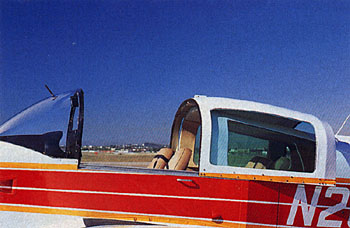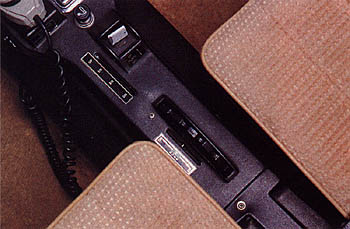
(click on image above to view full sized version - 45K) |
 (click on image above to view full sized version - 50K) |
|
baggage door, and ancilliary controls on the center console. |
|
Four comfy
seats under a canopy make the Tiger a good single-family hauler. |
The wet-wing tanks aren't prone to leaking, but still look for telltale stains at the strap covering the junction of the inboard and outboard wing sections. Tiger values reflect its vaunted standing in the used market. According to Vref (see: www.aopa.org/memberslvref), a 1975 AA-5B should sell for $47,000; prices climb predictably to the 1979's value of $53,500. Put that in perspective: A 1972 Traveler is worth just $28,000, while a 1979 Cheetah goes for just $34,500. Meanwhile, a 1991 AG5B is worth $75,000 today; American General built just 150 of the Tigers between 1990 and 1993. That the American General Tiger didn't survive is more a reflection of the economic times at the beginning of the 1990s than the design itself. More than two decades after the last Grumman Tiger rolled off the line, the plucky four-placer remains in solid demand, appreciating steadily and earning accolades from new owners. Moreover, a new company is ready to build you a new one, for $214.000. TLM Aircraft. a subsidiary of Tong Lung Metal Industries, has built a plant in Martinsburg, West Virginia; it intends to revive the AA-5A Cheetah as well. (consider this move just another testament to the careful balance of performance over cost and maintenance requirements; few light aircraft have made these compromises as well as the Tiger. |
| Otherwise, the Tiger's airframe is rugged enough that few specialized inspections are necessary; just look at the usual list of consumables-brakes, tires, propeller condition, etc. (There's a repetitive airworthiness directive on the McCauley prop and an annoying rpm limitation; many owners have switched over to the Sensenich prop with good results.) Engine baffling is perhaps more critical on the Tiger than on other 0-360-powered airplanes. In their quest to extract maximum cruise speeds, Grumman and LoPresti cut down the cooling margins. |

(click on image above to view full sized version - 61K) |

(click on image above to view full sized version - 71K) |
WITH CLAWS STILL SHARP • Marc E. Cook • Photography by Mike Fizer • AOPA PILOT • MAY 1999
Home | Page 1 | Page 2 | Page 3 | Page 4 | Page 5
